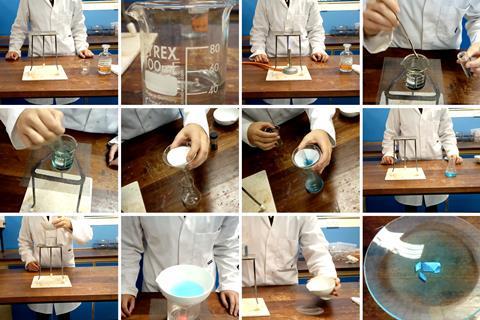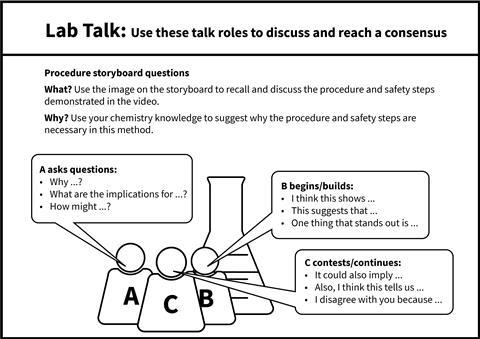Enhance your chemistry practicals and improve student outcomes with collaborative research ideas from Naomi Hennah and Michael Seery

Like all teachers, we constantly try to refine our practice and resources to better support learning. Both of us share a particular interest in making the most of practical work so that students both do it and learn from it. We collaborated on a project using videos for pre-lab preparation, which encouraged students to verbalise their understanding of the procedure they were using. We found there were many benefits when teachers and researchers collaborate, and we later published two research papers together. The Royal Society of Chemistry (RSC) has made the second paper, A holistic framework for developing purposeful practical work, free to access.
Research in the school lab
We focused on 14–16 chemistry practical tasks in this research. These tasks, required for terminal assessment, are high-stakes episodes, as there is not enough curriculum time to keep repeating them until both the procedures and underlying concepts are mastered. We used an opportunity to collaborate to discover more about learning in the school laboratory facilitated by the support of the RSC Chemical Education Research Group Teacher Researcher scheme. This research meant that we were learning about laboratory work as it was happening in schools.
One video, two voice-overs
The project built on our prior work in laboratory education, and combined Naomi’s interest in language and learning and Michael’s experience in designing an undergraduate laboratory curriculum informed by cognitive load theory. As such, it provided a fresh perspective for understanding activities tailored towards the GCSE practical endorsement. Initially our work was concerned with developing the use of videos to prepare students for carrying out practical work. We worked together with an undergraduate chemistry student, Sophie, who made the ‘One video, two voice-overs’ resources as part of her final year project. These videos separate the procedural knowledge needed to carry out a task from the conceptual knowledge concerned with understanding the underlying theory by providing different voice-overs for the same video.
Prep videos for lab work
The project videos are freely available for you to use with your students:
- The Making salts procedure video looks at how the equipment is used to produce dry copper sulfate crystals from copper oxide and sulfuric acid.
- The Making salts concepts video covers the chemical concepts behind producing dry copper sulfate crystals from copper oxide and sulfuric acid.
- The Electrolysis procedure video describes the electrolysis of copper(II) chloride, copper(II) sulfate, sodium chloride, sodium sulfate, and looks at how the equipment is used for the electrolysis of salt solutions.
- The Electrolysis concepts video considers the chemical concepts required for electrolysis of salt solutions.
Optimise the team
We introduced ‘Lab roles’ and ‘Lab talk’ to facilitate a more equitable and collaborative environment. We put the students into groups of three to reduce potential issues caused by the absence a group member, but the groups were still small enough to ensure everyone was engaged. Students remained in these groups for all their practical work, so they became accustomed to working together.
First, we asked students to watch the procedural video as a homework activity before the practical lesson. Then, after they carried out the task in class, we asked them to watch the conceptual version as recap homework. This, in effect, expanded the practical lesson without impacting on lesson time. To encourage the students to watch the video, we developed a talk-based reverse storyboarding activity. Reverse storyboarding describes visual summarising of existing video footage. For the activity, the groups of three had to reconstruct the procedure using the Lab talk protocol.
Students benefit from these interventions and achieve significantly higher attainment scores in GCSE chemistry exam practical-themed questions
The students created the reverse storyboard by snipping images from the practical video, attaching the questions ‘What?’ and ‘Why?’ to each image. We were able to create an active learning environment by using reverse storyboarding, where the groups worked together to build a joint understanding of the procedure and of why the steps were necessary. Once they had completed the reverse storyboard and the teacher had checked it, students carried out the practical task. They were encouraged to try to continue using the Lab talk protocol while carrying out the practical activity.

To ensure each member of the trio fulfilled a specific purpose, lab roles were introduced to establish a more equitable team. The three lab roles were rotated within each group for each practical task, so every student experienced every role a few times throughout the year.
Getting started with CHAT
We used cultural-historical activity theory (CHAT) to identify factors that impact learning in practical work. CHAT considers human cognition and development as products of social interaction. The relationship between subject and object is pictured as a triangle, known as the activity system. Every aspect of the system affects, and is affected by, the other aspects, constituting the activity that produces the outcome. In this case, the object is learning and carrying out the GCSE practical task, and the outcome is student answers to practical-themed questions. The ‘One video, two voice-over’ resources and reverse storyboarding activities are tools that develop the individual’s and the group’s prior knowledge before undertaking the task. Lab talk and Lab roles support collaboration and relate to the division of labour.










1 Reader's comment